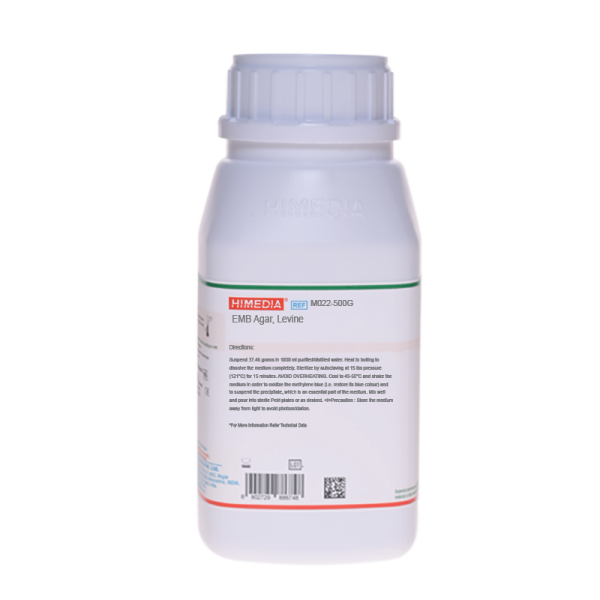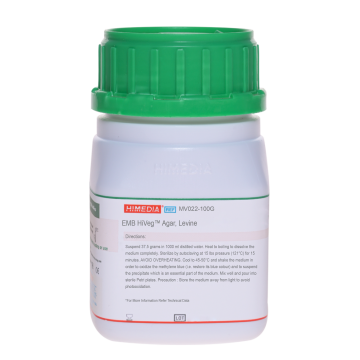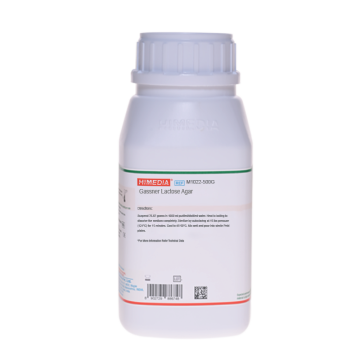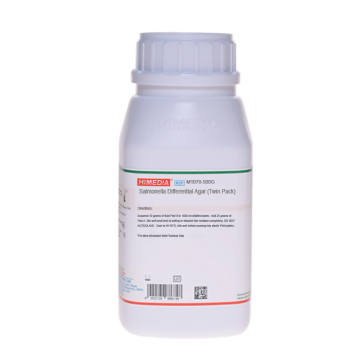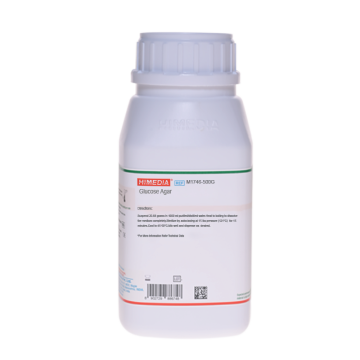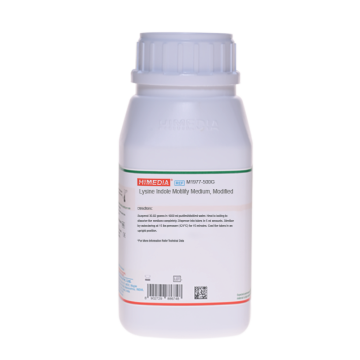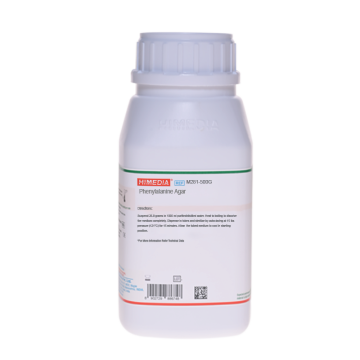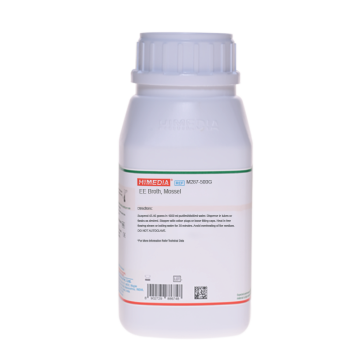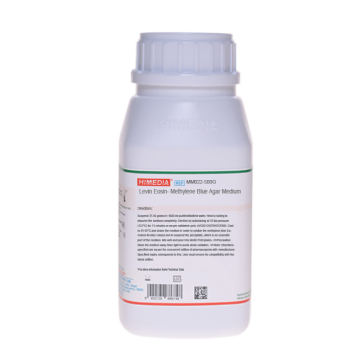 Your enquiry has been submitted
Your enquiry has been submitted
EMB Agar, Levine
Enterobacteriaceae#CC293D
Intended Use
Recommended for the isolation, enumeration and differentiation of members of Enterobacteriaceae from clinical and non clinical samples.
Composition
| Ingredients | g / L |
|---|---|
| Peptone | 10.000 |
| Dipotassium hydrogen phosphate | 2.000 |
| Lactose | 10.000 |
| Eosin - Y | 0.400 |
| Methylene blue | 0.065 |
| Agar | 15.000 |
Final pH (at 25°C): 7.1±0.2
**Formula adjusted, standardized to suit performance parameters
Directions
Suspend 37.46 grams in 1000 ml purified/distilled water. Heat to boiling to dissolve the medium completely. Sterilize by autoclaving at 15 lbs pressure (121°C) for 15 minutes. AVOID OVERHEATING. Cool to 50°C and shake the medium in order to oxidize the methylene blue (i.e. restore its blue colour) and to suspend the precipitate, which is an essential part of the medium.
Precaution: Store the medium away from light to avoid photo-oxidation.
Principle And Interpretation
Levine EMB Agar was developed by Levine (1,2) and is used for the differentiation of Escherichia coli and Klebsiella aerogenes and also for the rapid identification of Candida albicans. This medium is recommended for the detection, enumeration and differentiation of members of the coliform group by American Public Health Association (3,4,5). Weld (6,7) proposed the use of Levine EMB Agar, with added Chlortetracycline hydrochloride, for the rapid identification of Candida albicans in clinical specimens. A positive identification of Candida albicans can be made after 24-48 hours incubation at 35-37°C in 10% carbon dioxide atmosphere, from specimens such as faeces, oral and vaginal secretions and nail or skin scraping etc. However, the typical appearance is variable.
Eosin Y and methylene blue make the medium slightly selective and inhibit certain gram-positive bacteria. These dyes serve as differential indicators in response to the fermentation of carbohydrates. This helps to differentiate between lactose-fermenters and non-fermenters in EMB Agar, Levine. The ratio of eosin-methylene blue is adjusted to approximately 6:1. Coliforms produce purplish black colonies due to uptake of methylene blue-eosin dye complex, when the pH drops. The dye complex is absorbed into the colony. Non-fermenters probably raise the pH of surrounding medium by oxidative de-amination of protein, which solubilizes the methylene blue-eosin complex resulting in formation of colourless colonies. Peptone serves as source of carbon, nitrogen, long chain amino acids, vitamins and other essential growth nutrients. Lactose serves as the source of energy by being the fermentable carbohydrate. Eosin-Y and methylene blue serve as differential indicators. Phosphate buffers the medium.
The test sample can be directly streaked on the medium plates. Inoculated plates should be incubated, protected from light. However standard procedures should be followed to obtain isolated colonies. A non-selective medium should be inoculated in conjunction with EMB Agar. Confirmatory tests should be further carried out for identification of isolated colonies.
Type of specimen
Clinical samples - urine, faeces, oral and vaginal secretions and nail or skin scraping, Foodstuffs; Water samples.
Specimen Collection and Handling
For clinical samples follow appropriate techniques for handling specimens as per established guidelines (8,9).
For food and dairy samples, follow appropriate techniques for sample collection and processing as per guidelines (5,10).
For water samples, follow appropriate techniques for sample collection, processing as per guidelines and local standards (3).
After use, contaminated materials must be sterilized by autoclaving before discarding.
Warning and Precautions
In Vitro diagnostic use. For professional use only. Read the label before opening the container. Wear protective gloves/protective clothing/eye protection/face protection. Follow good microbiological lab practices while handling specimens and culture. Standard precautions as per established guidelines should be followed while handling clinical specimens. Safety guidelines may be referred in individual safety data sheets.
Limitations
- A non-selective medium should be inoculated in conjunction with EMB Agar.
- Confirmatory tests should be further carried out for identification of isolated colonies.
- Some strains of Salmonella and Shigella species do not grow in the presence of eosin and methylene blue.
Performance and Evaluation
Performance of the medium is expected when used as per the direction on the label within the expiry period when stored at recommended temperature.
Quality Control
Appearance: Light pink to purple homogeneous free flowing powder
Gelling: Firm, comparable with 1.5% Agar gel
Colour and Clarity of prepared medium: Reddish purple coloured, opalescent gel with greenish cast and finely dispersed precipitate forms in Petri plates
Reaction: Reaction of 3.75% w/v aqueous solution at 25°C. pH: 7.1±0.2
pH: 6.90-7.30
Cultural Response: Cultural characteristics observed after an incubation at 35-37°C for 24-48 hours.
| Organism | Inoculum (CFU) | Growth | Recovery | Colour of Colony |
|---|---|---|---|---|
| Candida albicans ATCC 10231 (00054*) | 50-100 | luxuriant (incubated in 10% carbon dioxide) | >=50% | colourless |
| # Klebsiella aerogenes ATCC 13048 (00175*) | 50-100 | good | 40-50% | pink-red |
| Escherichia coli ATCC 25922 (00013*) | 50-100 | luxuriant | >=50% | blue-black with metallic sheen |
| Enterococcus faecalis ATCC 29212 (00087*) | 50-100 | none-poor | <=10% | colourless |
| Pseudomonas aeruginosa ATCC 27853 (00025*) | 50-100 | luxuriant | >=50% | colourless |
| Staphylococcus aureus subsp. aureus ATCC 6538 (00032*) | 50-100 | none-poor | <=10% | colourless |
| ^Pseudomonas paraeruginosa ATCC 9027 (00026*) | 50-100 | luxuriant | >=50% | colourless |
| Salmonella Typhimurium ATCC 14028 (00031*) | 50-100 | luxuriant | >=50% | colourless |
| Saccharomyces cerevisiae ATCC 9763 | 50-100 | none-poor | <=10% | cream |
| Staphylococcus aureus subsp. aureus ATCC 25923 (00058*) | 50-100 | none-poor | <=10% | colourless |
| Escherichia coli ATCC 8739 (00012*) | 50-100 | luxuriant | >=50% | blue-black with green metallic sheen |
Key: (*) Corresponding WDCM numbers.
(#) Formerly known as Enterobacter aerogenes ^ Formerly known as Pseudomonas aeruginosa
Storage and Shelf Life
Store between 10-30°C in a tightly closed container and the prepared medium at 20-30°C. Use before expiry date on the label. On opening, product should be properly stored dry, after tightly capping the bottle in order to prevent lump formation due to the hygroscopic nature of the product. Improper storage of the product may lead to lump formation. Store in dry ventilated area protected from extremes of temperature and sources of ignition Seal the container tightly after use. Product performance is best if used within stated expiry period.
Disposal
User must ensure safe disposal by autoclaving and/or incineration of used or unusable preparations of this product. Follow established laboratory procedures in disposing of infectious materials and material that comes into contact with clinical sample must be decontaminated and disposed of in accordance with current laboratory techniques (8,9).
Reference
- Levine M., 1918, J. Infect. Dis., 23:43.
- Levine M., 1921, Bull. 62, Iowa State College Engr. Exp. Station.
- Lipps WC, Braun-Howland EB, Baxter TE,eds. Standard methods for the Examination of Water and Wastewater, 24th ed. Washington DC:APHA Press; 2023.
- Marshall R. (Ed.), 1992, Standard Methods for the Examination of Dairy, Products, 16th ed., APHA Inc., New York.
- Salfinger Y., and Tortorello M.L., 2015, Compendium of Methods for the Microbiological Examination of Foods, 5th Ed., American Public Health Association, Washington, D.C.
- Weld J. T., 1952, Arch. Dermat. Syph., 66:691.
- Weld J. T., 1953, Arch. Dermat. Syph., 67(5):433.
- Isenberg, H.D. Clinical Microbiology Procedures Handbook 2nd Edition.
- Jorgensen, J.H., Pfaller, M.A., Carroll, K.C., Funke, G., Landry, M.L., Richter, S.S and Warnock., D.W. (2015) Manual of Clinical Microbiology, 11th Edition. Vol. 1.
- American Public Health Association, Standard Methods for the Examination of Dairy Products, 1978, 14th Ed., Washington D.C.
| Product Name | EMB Agar, Levine |
|---|---|
| SKU | M022 |
| Product Type | Regular |
| Physical Form | Powder |
| Origin | Animal |
| Packaging type | HDPE |
| References | 1. Levine M., 1918, J. Infect. Dis., 23:43. 2.Levine M., 1921, Bull. 62, Iowa State College Engr. Exp. Station. 3.Baird R.B., Eaton A.D., and Rice E.W., (Eds.), 2015, Standard Methods for the Examination of Water and Wastewater,23rd ed., APHA, Washington, D.C. 4.Marshall R. (Ed.), 1992, Standard Methods for the Examination of Dairy ,, Products, 16th ed., APHA Inc., New York. 5.Salfinger Y., and Tortorello M.L. Fifth (Ed.), 2015, Compendium of Methods for the Microbiological Examination ofFoods, 5th Ed., American Public Health Association, Washington, D.C. 6.Weld J. T., 1952, Arch. Dermat. Syph., 66:691. 7.Weld J. T., 1953, Arch. Dermat. Syph., 67(5):433. 8.Howard B. J., 1994, Clinical and Pathogenic Microbiology, 2nd Ed., Mosby Year Book, Inc 10.Downes F. P. and Ito K., (Ed.), 2001, Compendium of Methods for the Microbiological Examination of Foods, 4th Ed.,American Public Health Association, Washington, D.C. 11. Isenberg, H.D. Clinical Microbiology Procedures Handb0ook. 2nd Edition.12 Jorgensen,J.H., Pfaller , M.A., Carroll, K.C., Funke, G., Landry, M.L., Richter, S.S and Warnock., D.W. (2015) Manual of Clinical Microbiology, 11th Edition. Vol. 1. |
| Customized Product Available | No |



